実施日 : 2012年10月16日(火) - 17日(水)
Notice: Wakayama Press Tour “Kumano Sanzan, Sacred World Heritage Site, Prepared to Live with Nature” (October 16-17, 2012)
投稿日 : 2013年08月23日
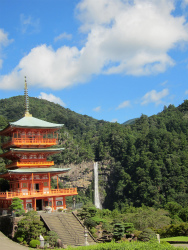 Kumano Sanzan (three Grand Shrines of Kumano: Kumano Hongu Taisha, Kumano Hayatama Taisha, and Kumano Nachi Taisha), which have been greeting people as sacred sites of nature worship for more than 1,000 years, are a World Heritage Site. In the Kumano region, it has been a social custom to make a pilgrimage to the three shrines because this pilgrimage originated from people’s worship of nature itself: mountains, forests, rocks, rivers and cascades, which were formed in the leading rainy region in the island of Honshu.
Kumano Sanzan (three Grand Shrines of Kumano: Kumano Hongu Taisha, Kumano Hayatama Taisha, and Kumano Nachi Taisha), which have been greeting people as sacred sites of nature worship for more than 1,000 years, are a World Heritage Site. In the Kumano region, it has been a social custom to make a pilgrimage to the three shrines because this pilgrimage originated from people’s worship of nature itself: mountains, forests, rocks, rivers and cascades, which were formed in the leading rainy region in the island of Honshu.
People from commoners to nobles from all over Japan trekked along steep mountain paths and crossed rapid rivers to get to Kumano, believing that the harder the trek was, the greater the blessing of the Kumano deities. In 2004, three sacred places ---Koyasan, Yoshino and Omine--- and pilgrimage routes connecting all of them, were registered on the World Heritage List as the Sacred Sites and Pilgrimage Routes in the Kii Mountain Range. At present there are only two routes of faith in the world; the other is the Way of St. James in Spain.
The annual mean precipitation in the areas along the Kumano River is about 2,800 mm, about 1.6 times higher than that of Japan as a whole---1,700 mm. Water nurtures rich nature in this place, but at the same time has repeatedly caused disasters. In September last year, Typhoon 12 (Talas), which wrought great damage in Wakayama Prefecture, leaving more than 60 persons dead or missing, flooded the Kumano River, also damaging the Kumano Sanzan by flooding or landslides. This time the precipitation during the five days from August 30 to September 4, 2011, was about 2,000 mm, a record downpour.
One year after the typhoon disaster, Kumano Sanzan, now recovering its original beauty, is greeting pilgrims and tourists as it did before the disaster. Meanwhile, Kumano Hayatama Taisha will celebrate the “Mifune Matsuri” festival on October 16, to publicize across Japan how well Kumano is doing.
 The tour will visit Kumano Sanzan to watch the Mifune Matsuri festival on October 16. It will also cover the lives of people who are living in harmony with nature in an environment subject to occasional damage by water. At Nachi Katsuura Cho (town), where the damage was particularly severe, Mr. Shinichi Teramoto, mayor of the town, will talk about how he is tackling rehabilitation. At Hirokawa Cho, the tour will visit the Inamura-no-Hi no Yakata, which passes down to the present day the actual tsunami damage caused by the 1854 Ansei-Nankai Earthquake, and the people’s awareness of disaster prevention these days. At the end of the tour, Mr. Yoshinobu Nisaka, Governor of Wakayama Prefecture, will talk about disaster prevention and reduction as he aims at realizing a safe and disaster-resistant Wakayama.
The tour will visit Kumano Sanzan to watch the Mifune Matsuri festival on October 16. It will also cover the lives of people who are living in harmony with nature in an environment subject to occasional damage by water. At Nachi Katsuura Cho (town), where the damage was particularly severe, Mr. Shinichi Teramoto, mayor of the town, will talk about how he is tackling rehabilitation. At Hirokawa Cho, the tour will visit the Inamura-no-Hi no Yakata, which passes down to the present day the actual tsunami damage caused by the 1854 Ansei-Nankai Earthquake, and the people’s awareness of disaster prevention these days. At the end of the tour, Mr. Yoshinobu Nisaka, Governor of Wakayama Prefecture, will talk about disaster prevention and reduction as he aims at realizing a safe and disaster-resistant Wakayama.
1. Kumano Sanzan*
~The Origin of Japanese Spiritual Culture ~
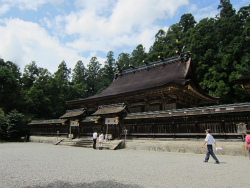 Most of the Kumano Hongu Taisha was lost in a flood in 1889. This year marks the 120th anniversary since the relocation of what was left and the reconstruction of the shrine on a hill. About 120 years ago, Kumano Hongu Taisha was situated on a sandbank in the Kumano River known as Oyunohara where 10 cm of mud was deposited by last year’s flood. Kumano Hayatama Taisha, located at the mouth of the Kumano River, has a place of worship from ancient times called Mifune Island, which was damaged by a torrent of mud last year. A landslide carried earth and sand inside the precincts of Kumano Nachi Taisha, a place of worship of the highest waterfall in Japan, Nachi-no-Otaki. Even after confronting harsh nature, the people of Kumano never forget the bounty of nature.
Most of the Kumano Hongu Taisha was lost in a flood in 1889. This year marks the 120th anniversary since the relocation of what was left and the reconstruction of the shrine on a hill. About 120 years ago, Kumano Hongu Taisha was situated on a sandbank in the Kumano River known as Oyunohara where 10 cm of mud was deposited by last year’s flood. Kumano Hayatama Taisha, located at the mouth of the Kumano River, has a place of worship from ancient times called Mifune Island, which was damaged by a torrent of mud last year. A landslide carried earth and sand inside the precincts of Kumano Nachi Taisha, a place of worship of the highest waterfall in Japan, Nachi-no-Otaki. Even after confronting harsh nature, the people of Kumano never forget the bounty of nature.
Mr. Takashi Nabuchi, Manager of the Kawayu-Midoriya hot spring inn, located near Kumano Hongu Taisha, says: “Typhoon 12 was the kind of disaster that never happened before, even though flooding itself occurs every three to five years in the Kumano River basin. It really made me felt that nature is beyond human power”. The Kumano River Boat Center restarted its operations in April this year despite losing a boatman. Even after the disaster, the Boat Center does not give up on living with nature in Kumano.
On the day of this tour, the Mifune Matsuri, the grand festival of Kumano Hayatama Taisha, will be held. It is believed to have a history of more than 1800 years. The director of the Wakayama World Heritage Center, Mr. Tsujibayashi, will give us a briefing on Kumano Sanzan followed by visits to Kumano Sanzan with local storytellers to cover the lives of people who live side by side with nature. Then, in Nachi-Katsuura City, which suffered the most severe damage from the flood, Mayor Shinichi Teramoto will give us a briefing on the damage and the recovery situation.
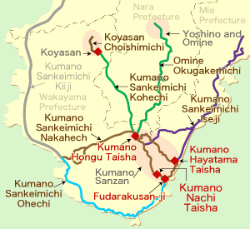
*Kumano Sanzan (Three Grand Shrines of Kumano)
Located in the southeastern part of the Kii Mountain Range, Kumano Sanzan includes the three shrines of Kumano Hongu Taisha, Kumano Hayatama Taisha and Kumano Nachi Taisha, all located some 20 to 40 km apart. Day 1 of the tour visits Kumano Hongu Taisha and Kumano Hayatama Taisha and day 2 of the tour visits Kumano Nachi Taisha.
・Kumano Hongu Taisha (Hongu Town, Tanabe City)
At the beginning of the Kumano pilgrimage, the pilgrims worship at Kumano Hongu Taisha through the Nakahechi route of “Kumano Kodo” (pilgrimage routes). It enshrines Ketsumikono-ookami. The tour will interview the head priest Rev. Kuki, and visit the Oyunohara where Kumano Hongu Taisha was situated about 120 years ago.
・ Kumano Hayatama Taisha (Shingu-City) / Mifune-matsuri
Located at the mouth of the Kumano River, Kumano Hayatama Taisha enshrines Kumanohayatamano-ookami. The tour follows a pilgrimage route to Kumano Hayatama Taisha by using river boats down the Kumano River, while hearing an introduction to the Mifune-matsuri (festival). Then, we can view the Mifune-matsuri from the boat.
・Kumano Nachi Taisha (Nachi-Katsuura Town)
Located halfway up the mountain, it enshrines Kumanofusumino-ookami and originates from the ancient nature worship of the highest waterfall in Japan, Nachi-no-Otaki. In the tour, a local storyteller will guide us from the main building of the shrine to Nachi-no-Otaki.
 2. Katsuura Fishing Port (Optional Tour)
2. Katsuura Fishing Port (Optional Tour)
The coast of Wakayama is known as the world’s northern limit of coral reefs and also as one of the best fishing spots because of the warm Kuroshio Current. Katsuura fishing port has the biggest fresh tuna-fish catch by longline fishing in Japan: 12,000 tons, 6.2 billion yen in market price.
On the second day, in the early morning, the tour visits a tuna fish auction with a guide from the fishing association. (The visit might be cancelled if there is no tuna fish auction on the day.)
3. Inamura-no-Hi no Yakata
~Preparation for the Future with the Lessons from the Past~
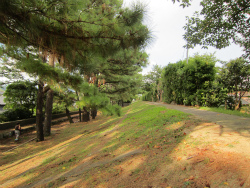 Hirokawa Town, Wakayama Prefecture, has a story behind its Tsunami Disaster Prevention Day, November 5th. “Inamura-no-Hi (the fire of rice sheaves)” is a story about Goryo Hamaguchi, the 7th president of Yamasa Soy Sauce Co.. The story tells that he helped the villagers to escape from a tsunami in the 1854 Ansei-era earthquake by setting fire to Inamura (stacks of rice sheaves) as a guide light. This story is published in an elementary school textbook to raisie awareness of Tsunami disasters. Moreover, it has been translated into the languages of eight Asian countries: Bangladesh, India, Indonesia, Malaysia, Nepal, the Philippines, Singapore and Sri Lanka. Goryo Hamaguchi, the hero of this story, not only saved the villagers’ lives but also invested in recovery efforts, hiring the villagers to construct a seawall at his own expense. This seawall is 600 meters long and 5 meters high, and it minimized the damage from the tsunami in the earthquake of 1946. Inamura-no-Hi no Yakata, teaching Goryo Hamaguchi’s achievements to the present day, has been attracting attention since the Great East Japan Earthquake as an educational base for tsunami disaster prevention.
Hirokawa Town, Wakayama Prefecture, has a story behind its Tsunami Disaster Prevention Day, November 5th. “Inamura-no-Hi (the fire of rice sheaves)” is a story about Goryo Hamaguchi, the 7th president of Yamasa Soy Sauce Co.. The story tells that he helped the villagers to escape from a tsunami in the 1854 Ansei-era earthquake by setting fire to Inamura (stacks of rice sheaves) as a guide light. This story is published in an elementary school textbook to raisie awareness of Tsunami disasters. Moreover, it has been translated into the languages of eight Asian countries: Bangladesh, India, Indonesia, Malaysia, Nepal, the Philippines, Singapore and Sri Lanka. Goryo Hamaguchi, the hero of this story, not only saved the villagers’ lives but also invested in recovery efforts, hiring the villagers to construct a seawall at his own expense. This seawall is 600 meters long and 5 meters high, and it minimized the damage from the tsunami in the earthquake of 1946. Inamura-no-Hi no Yakata, teaching Goryo Hamaguchi’s achievements to the present day, has been attracting attention since the Great East Japan Earthquake as an educational base for tsunami disaster prevention.
This tour visits Inamura-no-Hi no Yakata (Hirokawa Town, Wakayama Prefecture), which is designated as a temporary tsunami evacuation site, and the Hiromura Seawall built by Goryo Hamaguchi. Mr. Tooru Kumano, the director of Inamura-no-Hi no Yakata, will introduce the achievements of Goryo Hamaguchi and their activities to raise awareness of Tsunami disasters.
4. Interview with Wakayama Governor
Wakayama's Healing Powers and its Preparation for Disaster
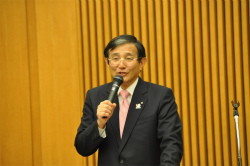 Besides World Heritage sites, we find comfort and healing in Wakayama Prefecture, where 30 million tourists visit every year, has the Port of Nachi Katsuura, which has one of the largest tuna catches in Japan, and the Adventure World, which has the highest number of pandas in Japan. The prefecture is also known as the birthplace of miso and shoyu, essential seasonings in Japanese dishes.
Besides World Heritage sites, we find comfort and healing in Wakayama Prefecture, where 30 million tourists visit every year, has the Port of Nachi Katsuura, which has one of the largest tuna catches in Japan, and the Adventure World, which has the highest number of pandas in Japan. The prefecture is also known as the birthplace of miso and shoyu, essential seasonings in Japanese dishes.
However, because of the decrease in tourists right after the Great East Japan Earthquake and of the effect of the water disaster caused by the record torrential rain brought by the Typhoon 12, which hit the Kii Peninsula, the number of tourists to Wakayama Prefecture in 2011 was less than 30 million for the first time in eight years. One year after the torrential rain disaster, however, the emergency rehabilitation of damaged roads and railways is complete. Making safety against disaster as one of its important policy pillars, Wakayama Prefecture appropriated a budget exceeding 570 billion yen in this fiscal year for the first time in 11 years, putting emphasis on rehabilitation projects from Typhoon 12 and on disaster prevention. Meanwhile, the Cabinet Office, at the end of August, announced damage estimate of the biggest possible earthquake that might occur along the Nankai Trough. The estimate says that a tsunami as high as 20 meters could hit Wakayama Prefecture and leave up to 80,000 people dead.
To sum up this press tour, Governor Nisaka will brief you on Wakayama’s attractions, the present situation of restoration and rehabilitation from the great damage caused by Typhoon 12, and preparations for a Nankai Trough earthquake and other possible large-scale disasters in the future.
*Foreign Press Center/Japan and Wakayama prefecture have co-organized this press tour. Tour participants bear part of the cost, but the purpose of the tour is not profit-making.
Tour Itinerary and Application Details
1. Tour itinerary (tentative):
Day 1: Tuesday, October 16
07:35 Leave Haneda Airport by JAL Flight 1381
08:45 Arrive at Nanki Shirahama Airport
09:45-10:15 Kumano Kodo, Takijiri-oji
11:15-12:15 Lunch at Kawayu Midoriya
(Interview with Manager of Kawayu Midoriya and Director of Wakayama World Heritage Center)
12:30-14:00 Interview with Chief Priest of Kumano Hongu Taisha
15:00-16:00 Boat trip down Kumano River
16:00-17:00 Mifune Matsuri
17:15-17:30 Kumano HayatamaTaisha
18:15-19:00 Press Conference by Mayor of Nachi Katsuura Town
19:15 Arrive at Hotel(Katsuura Onsen)
Day 2: Wednesday, October 17
07:00-07:40 Tuna Auction at Nachi Katsuura Cho Fishing Port (Optional)
08:00 Leave Hotel
08:30-10:00 Kumano Nachi Taisha, Nachi Falls
12:00-12:40 Lunch
14:20-15:40 Briefing by Tooru Kumano, Director, Inamura-no-hi noYakata
17:00-18:00 Press Conference by Governor of Wakayama Prefecture
19:55 Leave Kansai Airport by ANA Flight 148
21:15 Arrive at Haneda Airport
2. Qualification:
Participants must have Gaimusho Foreign Press Registration Cards
3. Cost:
13,000 per person including transportation, meals, and accommodation
*FPCJ will inform the participants of payment methods, cancellation fee etc. later on.
4. Participants:
Limited to the first 10 applicants on a first-come-first-served basis. (Only one reporter and one photographer from each organization, but two participants from each TV team will be acceptable.) If the number of applicants exceeds 10, an upper limit may be set on the number of participants from each country.
5. FPCJ Contact:
Mr. Yamaguchi (Tel: 03-3501-5070)
6. Remarks:
1) There may be some restrictions on photographing and filming in the press tour. Please follow the instructions of the officials on duty.
2) FPCJ and Wakayama Prefecture will not be liable for any inconvenience, trouble or accident that might occur in the course of the tour.


